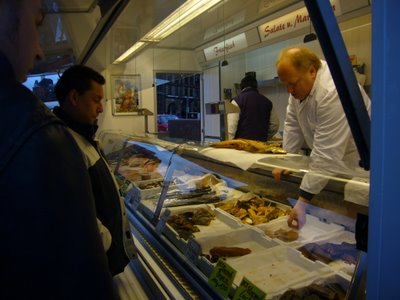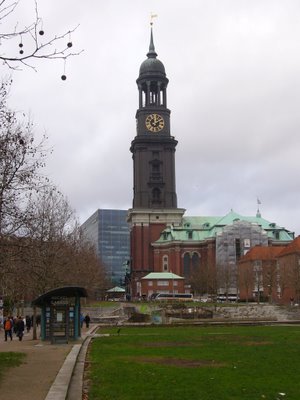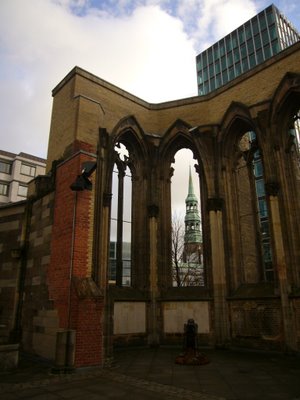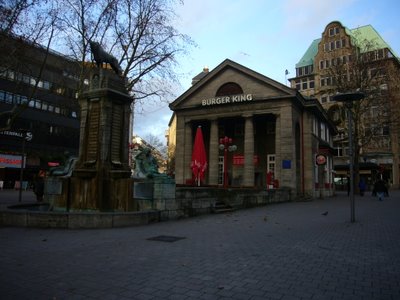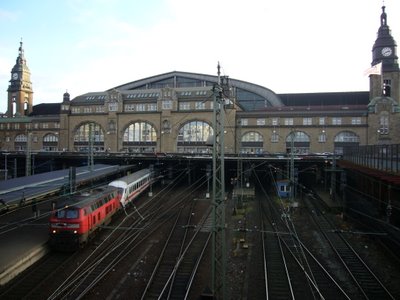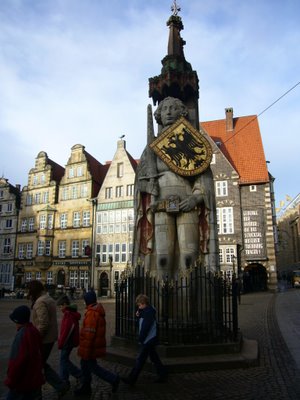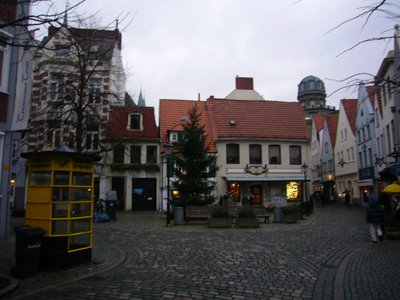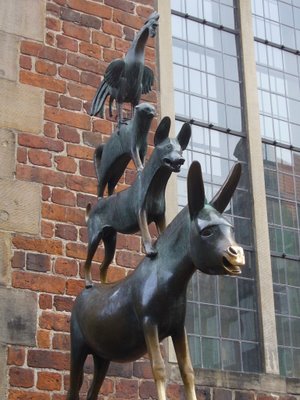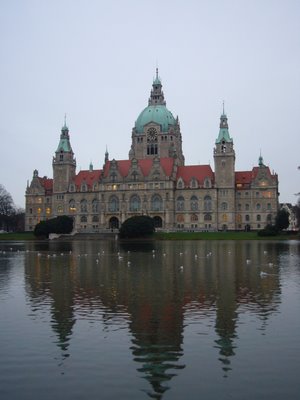
I arrived in
The countries golden age lasted primarily during the 1600s, after the end of a long war fought for sovereignty from
After checking into my hostel and storing my pack I headed out to explore the city that was then beginning to wake up. My hostel is pictured below.

I soon realized I would have to wait longer for museums and stores to open, so I decided to seek refuge from the sporadic drizzles inside Café Americain, a short walk from my hostel. The café is found in the large canal-corned hotel pictured below, which was founded in 1880. The interior of the café, reportedly one of the favorites of the local café scene, displays splendid examples of Art Deco style, with stained glass lamps and wall murals. Mata Hari even held her wedding reception here. I ordered a cup of coffee but was served much more than a simple cup of joe. Along with the coffee mug on my tin platter came four sugar cubes (two natural and two bleached), two raisin-sized chocolate nougats, a shot glass of water, another of cream, and a small chocolate bar complete with the cafe’s logo. From here on I knew this establishment was a few steps above a Starbuck’s. Finally around
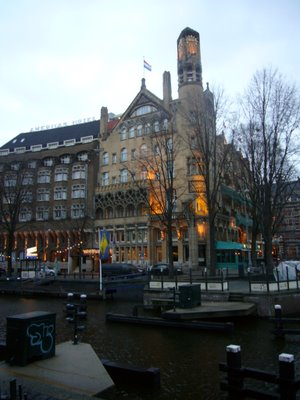
South of the city center lies the museum quarter, a number of the largest museums in the city surrounding a large grassy park void of any canals. I first visited the Rijksmuseum, which you see pictured at the top of the post. Unfortunately, the museum was undergoing renovations and only a limited amount of the collection was on display. However, the most famous of the paintings remained viewable to the public, such as works from Vermeer and Rimbrandt. The museum’s centerpiece is Rembrandt’s The Night Watch, but I honestly didn’t recognize it. Next, I visited the
After the museum I grabbed a quick lunch at the diner pictured below. At one point the room was filled shoulder with locals placing orders. The English-speaking couple next to me told me it was a popular place. I placed an order for bitterballs, an item which I had read was typical Dutch food. The white-jacketed server brought me a plate of eight fried balls, each roughly the size of a ping-pong. My questioning look caused the woman of that couple to laugh. I asked here what they were made from and she told me I wouldn’t want to know, but to try them with mustard. The insides of the golden brown spheres were gray and had the consistency of mashed potatoes, with small pink pieces of meat mixed in. The taste was alright; nonetheless I left the dinner understanding why I had never heard of Dutch cuisine before.
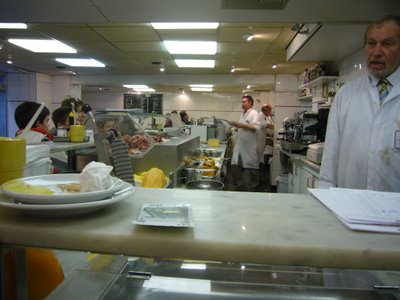
From there I attempted to walk straight to the Anne Frank House, but I found many distractions along the way.
I came across the Flower Market five minutes after leaving the diner. The 200 year-old and year-round operation consists of floating barges on one of the five main canals. Unfortunately, I presume that today’s market exists more for the tourists. Alongside the stands of flowers and bulbs, merchants stocked shelves of

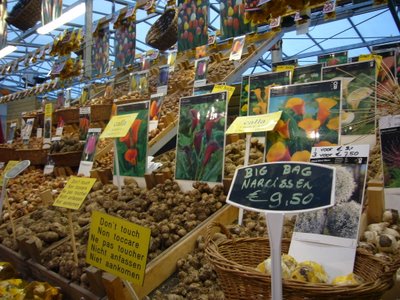
One of my favorite qualities of

I continued on my way to the Anne Frank House, pausing along the way to take photos. My one regret from visiting



Property owners built their homes and offices so tall and narrow due to the high taxes. In order to save room, owners even constructed stair cases very narrow and extremely steep. Rather than carrying furniture in an out on the stairs, residents use poles extruding from the gables and rope to move heavy items. A pulley at the end of the pole facilitates with the hoisting. Look at the gables of the houses to find the hoisting poles.

Eventually, I arrived at the Anne Frank House. It was in the attic of this typical canal house that Anne, her family, and a few other friends of her father hid during the Nazi occupation of the
Anne’s famous diary has been translated into over sixty languages. In middle school I read the script for the play, and watched the movie.
The building and its corner neighbor now house a museum about the incident. A walk through the museum gives one insight into Anne’s life for those two years. The swinging bookcase that hid the entrance to the attic remains, as do the photographs that Anne pasted to the wall of the room she shared with one of her father’s friends. Her room was the size of a standard bathroom. The museum staff leaves the attic windows covered as they would have been during Anne’s stay, creating a darkened setting. As I walked on the creaking floor I realized how difficult it must have been to keep quiet during the day in order to prevent someone downstairs from hearing noise and becoming suspicious. Below is the house from the outside, it’s the one to the left of the building into where the line of people enters. Photography from the inside was forbidden.
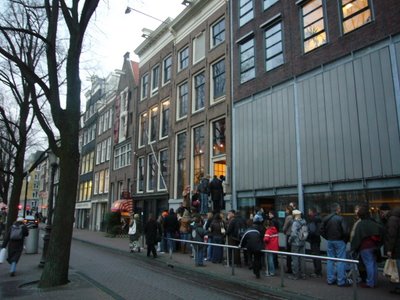
I find it ironic that this rather nondescript canal house was the setting for a story that captivated the world’s attention.
I wandered around the city as the day faded away. Before an actual meal I snacked on what looked like a local favorite, french fries served with mayonnaise in a paper cone. The mayonnaise combination tasted surprisingly good.
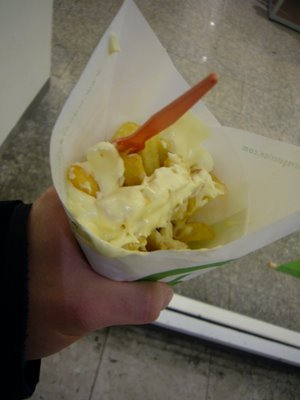
A little after

These women of the evening (actually they work during the day as well) advertise their wares and goods in canal-fronting windows illuminated by, but what else, a red light. Today the lights are fluorescent, and shine more for decorative purposes than the historical one, which was to inform passers-by that the women were available. Most of the prostitutes appear in the windows wearing only their lingerie, but others wear bikinis. A few conservative ones, if there is such a thing, wear jeans and a tight t-shirt. They appear to have free reign on how they want to present themselves; however, none expose themselves completely, although some wore rather skimpy underwear. A few women danced to music playing in their rooms, but most simply stand and smile seductively at onlookers. Many even sit in chairs reading books or sending text messages on their cell phones, looking up from time to time to see if that figure standing in front of their window is a potential customer or only a gawking tourist. A couple even looked unhappy. In order to grab my attention, the women often tapped on the glass as I walked by, and followed that up with a friendly smile and a come here motion. In one instance a prostitute even opened her door a crack and greeted me, “Hey sexy.” Needless to say, I kept walking.
To put it simply, I felt like I was window-shopping for sex. Another way to imagine it is as a combination of
One last bit of information, the prostitutes are regulated, registered, and taxed. Furthermore, since 1984 a union has represented these working women.
I took some pictures of the District, but only a few. I had heard before that if the women see you taking their picture they will send out their henchmen to take your camera. I didn’t want to risk it so I tried to be quick about it. The first one looks down the canal, without any views inside the windows. I took the last one of a bordello across the canal. It’s blurry, but one can see the figures standing in the windows. I left the District soon after taking that one. I walked away feeling the need for a cleansing shower, and while humming a certain song:
Roxanne, you don’t have to put on your red light.
Those days are over.
You don’t have to sell your body to the night.
Roxanne . . .


The next day I woke up early and checked out of the hostel after taking advantage of their breakfast buffet. I stored my pack at the train station, and then hoped on a cruise boat for a one hour tour on the canals. Pictured below is the boat on which I rode.
The cruise offered a beautiful perspective from which to view the city. The recorded narration in four languages epitomized



After the cruise I decided I couldn’t pass up the chance to experience the city like a local, on bike. I rode along the canals for a little time, while wondering how often someone accidentally rides off into one. Before long the prospect of seeing the Dutch countryside became too strong to resist.
I used the map the bike store gave me to find my way out to the rural land north of the city. First I had to use a ferry to cross the bay. Once across I was able to ride to the area known as the Waterland, that is after half an hour or so of first going in circles. My map also gave some good background information on the land.
About 1,000 years ago settlements appeared in the Waterland and the settlers began the process of reclaiming land from the sea. They drained the water away with canals and, starting in the 17th century, windmills. When the peat ground surface dried out it shrunk, which caused the ground to sink. Thus dykes became a necessity in the battle with the sea. A dam out on the
Breaking out of the urban area rewarded me with views of quaint villages and the Dutch countryside. I eventually found a trail on top of a dyke and rode along with the



As I stopped in one village to check the map I heard a click-clack sound behind me. I turned around to discover the source of the sound and couldn’t believe my eyes. An elderly woman had dismounted her bike and was now walking it. The click-clack came from her wooden shoes as they impacted the paved road. I had no idea that the wooden shoes were still used. She said hi to me and click-clacked along. I wanted to ask if her I could take her picture, but she soon remounted her bike and rode away. However, I was able to steal one shot when her back was to me, but the wooden shoes are difficult to discern.

Here are some more photographs from Waterland. Before this ride I had never seen flocks of swans before, only one or two at a time. The second photo is of the road as goes over a small canal and turns in front of the blue house. I eventually did see an old style windmill, but the sun was so low on the horizon I thought a photo would be pointless.

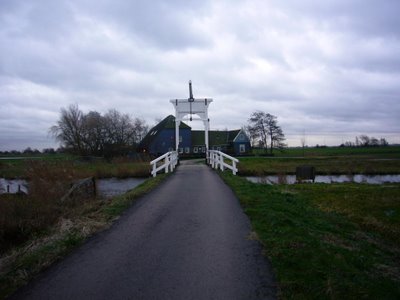
As I turned back toward
With a painfully empty stomach I searched for a restaurant at which to eat diner. My visit to the information center the day before provided me with a tip on Moeder’s. This restaurant on the edge of the trendy Jordaan District serves up typical Dutch cuisine. My meal consisted of a sausage, meatball, bacon, and mixture of mashed potatoes and cabbage. It appeared that Dutch cuisine was similar to German, heavy portion of meat without a bit of green on the plate.
I had a couple hours left before I needed to be at the train station, so I walked around the Jordaan District and enjoyed the scenery of the canals reflecting the neighborhood’s lights. I stopped in Café ‘t Smalle, one of the so called
One of my biggest surprises with
I was also pleasantly surprised to discover the similarity between Dutch and German. More than once I was able to understand the gist of a sign written in Dutch because of my German studies. In one café the bartender asked me a question in Dutch. I was able to understand one keyword in the sentence and answered her question with the German word, but in an attempted Dutch pronunciation. This is what I understood her to say, “oojes keish gooken taste?” Apparently I assumed and answered correctly.
I boarded my bus at around
It was a fast paced week, but I journeyed far and saw many sights. For the most part, Amsterdam was the most beautiful city for the week, although once can easily find the seedy areas of town or litter in the canals . Perhaps the week was too fast though. Even with my exploring speed I feel like I could have stayed in Amsterdam for another two days, and there are times when I felt the need to slow down and take it. In the end, I learned some good traveling lessons that I will be putting to practical use in a matter of weeks.
In twenty days or so the semester break will begin, and I will set out on my great European odyssey. Expect to hear more word on that in the days to come.As for the immediate future, tomorrow I travel with the International Association to Garmisch, a town in the Bavarian Alps. With any luck, there might actually be some snow.

